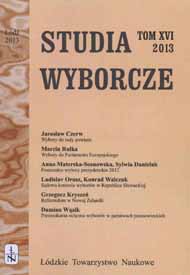INSTYTUCJA REFERENDUM W NOWEJ ZELANDII
THE INSTITUTION OF THE REFERENDUM IN NEW ZEALAND
Author(s): Grzegorz KryszeńSubject(s): Politics / Political Sciences
Published by: Łódzkie Towarzystwo Naukowe
Keywords: wybory; referendum; Nowa Zelandia.
Summary/Abstract: New Zealand is known as one of the most democratic countries of the world, especially thanks to the adopted institutional model of direct democracy. This model primarily consists of three types of national referendums: a constitutional referendum, a referendum initiated by the Government and since 1993 citizens initiated referendum (CIR). Among the five referendums on the constitutional nature which were carried out previously, two of them were related to the length of the term of office of the Parliament (1967 and 1990), and three of them electoral reform (1992, 1993 and 2011). A very large group in the second listed category of referendums, managed at the initiative of the Government, in the years 1911-1987 were to vote on alcohol licensing, which accompanied almost all then parliamentary elections. There had also been in the Government's initiative ordered five other referendums (three in 1949 and one in 1967 and 1997). The practice of using CIR is not so common. So far, four such referendums were held (one in 1995 and 2009, two – in 1999).We should seek causes of this fairly modest practice in imperfection of CIR regulation, as well as non-legislative factors. The institution of the referendum, despite not often used, seems to be, however, a permanent part of the constitutional law in New Zealand, with the strong support of the vast majority of citizens.
Journal: Studia Wyborcze
- Issue Year: 2013
- Issue No: 16
- Page Range: 93-111
- Page Count: 19
- Language: Polish

